Original URL: https://www.theregister.com/2013/02/15/cuppa_round_up/
Reg readers scuffle over the ultimate cuppa
Brews for all tastes, with a nasty dash of 'cofftea'
Posted in Science, 15th February 2013 12:39 GMT
Poll We weren't much surprised that last week's call for readers to explain just what makes the ultimate cuppa resulted in a rush of experts eager to chip in their two bits' worth, offering some strong opinions, and even stronger brews, as evidenced by tales of billy-can-boiled industrial-strength infusions sweetened with condensed milk and shovelfuls of white sugar.
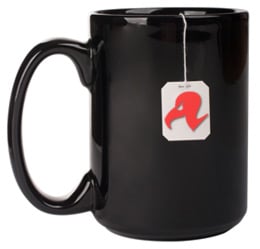 While such concoctions may offend the delicate sensibilities of the tea-sipping gourmet, they do at least fall within the broad classification of "cuppa", unlike the satanic melange which is known to its disciples as "cofftea".
While such concoctions may offend the delicate sensibilities of the tea-sipping gourmet, they do at least fall within the broad classification of "cuppa", unlike the satanic melange which is known to its disciples as "cofftea".
Yup, it didn't take one Reg reader to stray from the path of righteousness with a chilling recipe for this "fatigue-defying nectar" comprising "mug of boiling water + 2 teabags, stew to oblivion and add 2 or 3 spoonfuls of good instant coffee...add milk or, ideally, powdered creamer like CoffeeMate".
"You sick, sick man," responded one shaken reader, who presumably then needed a sit down and a nice cup of tea with a healthy shot of whisky to recover from the shock.

Cofftea? NOOOOOO!
By way of warning, the perpetrator of this outrage is banned from El Reg for a month, as are those who interpreted our invitation to discuss tea as a cue to bang on about their favourite coffee. As one participant put it: "This is no place for coffee drinkers. Let them go to perdition for the nasty foreigners and traitors they surely are."
Quite so. Now, having dealt with the punitive formalities, we can get down to business. The following selection of contributions demonstrates the breadth of ritual practised by worshippers at the Church of Cha:
1. Mug
2. Tea, normal English (e.g. Yorkshire) brewed strong as death
3. Milk, skimmed or semi-skimmed, just a spot
No sugar. That's for coffee, and even then it should be brown.
That's Richard 81's basic take. Seanmon, "a man who used to run a cafe", reckoned:
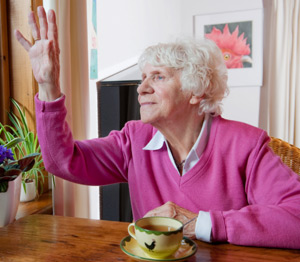
Don't forget the cosy, dear
First, you need a teapot. Decent tea can't be made in a cup. Second, you need a teacosy for that pot. Your Gran didn't get to be that old without learning a few things y'know.
The correct ratio is 3 teabags to 750ml of water - i.e approx 1 per mug. Many teabags are acceptable - Nambarrie for me, however Yorkshire, 99, co-op own brand or, in a pinch, Scottish blend are OK. The only thing that's not really acceptable is Tetley's.
The water should be poured into the (warmed!) pot at boiling point, so a little splashes out onto your hands. Anything worth having requires a little sacrifice. Also, the pot should contain the very dregs of the last brew - a useful technique here is to drain the pot, then squeeze the dregs out of the discarded teabags back in.
Leave it for at least 5 minutes - this is where that teacosy comes in. In the meantime, fill your mug with boiling water to get it nice and hot. Discard before serving, obviously.
The tea should be poured onto the veriest dribble of milk - I define the amount as "slightly more than no point."
Adam Titmus is also a pot aficionado. Here's his recipe:
1. Warm the pot.
2: Loose tea (I use Yorkshire Gold normally, although I've had good Kenyan and Assam blends at one time or another) - 1 heaped teaspoonful + 1 per mug.
3: Fresh boiling water, roughly half a pint per half pint mug, but reducing per mug (the amount absorbed by the tea leaves offsets the volume of milk for the first mug, less so for multiple mugs.)
4: Stand for 3 minutes.
5: 60ml full fat milk and one and a half heaped teaspoonfuls of sugar (down from NATO-standard two in my youth) per half pint mug.
6: Pour tea in last, through your favourite strainer.
7: Stir!
8: Drink.
If that seems like a right palaver, here's another no-frills approach, favoured by Jim Barter:
I prefer Yorkshire tea, 1 clean mug, boiling water onto the bag (Sheffield water is the best in the country) (and not just off the boil either...pah) Steep for 2 minutes then agitate and compress the bag on withdrawal, add a dash of milk, no sugar.
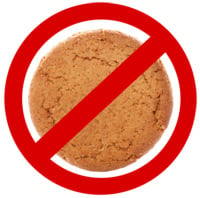 Jim then breaks the "no discussion on biscuits" rule by adding: "A nice shortbread or Rich Tea is entirely suitable, sometimes a Ginger Nut if feeling adventurous."
Jim then breaks the "no discussion on biscuits" rule by adding: "A nice shortbread or Rich Tea is entirely suitable, sometimes a Ginger Nut if feeling adventurous."
As we've already said, we're leaving the ultimate biccie debate until a later date, at which point the Chocolate Digestive will most certainly triumph. Furthermore, we have no desire to hear about Jim getting adventurous with his Ginger Nuts.
So, moving swiftly on, let's hear from Mr Davis, who admitted to becoming "pretty obsessed with my tea brewing:
Mug must be pre-warmed. One tea bag in cup – Yorkshire Gold or Yorkshire tea if no Yorkshire Gold available. Anything else then teabag must be left in. The second the water boils get it into the cup. Cover the top of the cup, I use tinfoil (see attached).
This really does work well and improves the flavour better than using two bags. Leave for 10 - 15 minutes. Any longer and it needs a re-heat for 15 seconds in the microwave. Add the tiniest drop of milk.
Interesting methodology. Joe Beaumont opined:
Bag: PG Tips for a work-a-day brew or Yorkshire Gold for a more mellow infusion.
Water: Tap (not filtered) and freshly drawn into the kettle.
Pour: Bag in first. Pour the just boiled (NOT boiling) water directly onto the bag. Pour in from a great height so you get more air (and thus more oxygen) in the mix. I swear by this bit, although it does look (and sound) odd.
Brew: As long as desired.
Milk: In last.
Sugar: I’m not even entertaining the idea.
Shultz agreeably proposed a quick shufti at The Register might form an integral part of the tea ceremony:
(1) Start the boiler
(2) Read a climate change / no change article on El Reg (gets your blood pressure high enough to get up again)
(3) Pour hot water over tea / tea bag
(4) Post an 85 word comment about the (lack of) science on climate change
(5) Remove tea / tea bag and add a little milk
(6) Read the rest of El Reg, sip your tea, and relax
And finally, here's TRT's method for the engineers among you:
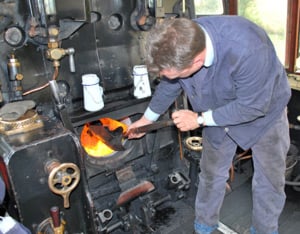
Right, I'll just stick the kettle on
(1) Throw a scoop of tea leaves into the stoker's pot with water drawn off from the cylinder cock drain valve. Stir with a spanner.
(2) Leave on the hotplate next to the firebox for about six miles.
(3) Tie a rope onto the handle and spin furiously around out of the cab between stations to centrifuge down the leaves.
(4) Pour the supernatant into two enamel mugs, each with a generous splash of unpasteurized milk. Use a coal hammer to knock a lump off the sugarloaf kept wrapped in brown parcel paper and drop in mug.
(5) Hand one mug to the driver and enjoy, ignoring the oil slick on the top, as that's what gives it the flavour.
As you can see, we're no nearer to identifying the ultimate cuppa, and as one commenter put it, it's pretty much a case of "brew what thou wilt shall be the whole of the law".
Nonetheless, we do need to identify key elements in the process if we're to formulate a test regime. The following are, in our opinion, the vital areas of consideration...
What tea?
We're never going to get a consensus on this one, so let's just serve up choice selection of reader preferences for your sipping pleasure.
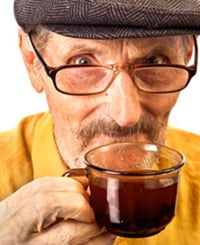
Neil Barnes sips Lapsang Souchong
Roger Byrne offered: "Well I would always go for a pure Assam tea. There are some good blends about but none match the depth of flavour of a good Assam. It does have to be brewed properly of course, no dunking a teabag in the cup for a couple of seconds, as it takes time for the flavour to develop."
Assam proved a popular choice, although "if you can't get it (i.e. live somewhere outside the UK and India) then Ceylon would be my second suggestion" noted one anonymous participant. "Not as good as Assam but OK," he/she conceded.
Our own Neil Barnes, he of SPEARS board fame, voted for "Lapsang Souchong - prince of teas". Showing his age, he continued: "Gunpowder teas are acceptable; green teas or even Earl Grey in a pinch."
Jai reported his grandfather's divine DIY brew involves "one part Earl Grey to 3 parts English Breakfast". That's not exotic enough for Phil Launchbury, who's apparently a part-time chai blender:
50% Yorkshire loose leaf tea (hard water variety) – a really good basic tea
10% Lapsang-Souchong (for the smokiness)
30% Earl Grey (for the high notes)
10% (other) – varies depending on mood – can be Darjeeling or Russian Caravan tea or sometimes Gunpowder tea.
Other candidates included loose Russian Caravan (Guy Middleton), Fortnum & Mason's Jubilee blend (David Evans), Sainsburys red label bags (Nick Hardy), Betty's (only available in York, Harrogate, Northallerton or Ilkely, Mark Knebel Daniels notes), Make Us A Brew Tea Company's English Breakfast blend (Sam Smallwood), Twinings Earl Grey (Tim Johnson), Madura (a low caff black tea available in Oz, according to John Tserkezis), Barry's Tea (Frumious Bandersnatch) and, god preserve us, Oz Bush Wattleseed (mutatedwombat).
Bag or loose?
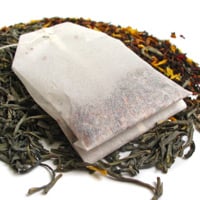 Andrew Hill was unimpressed with my admission that I use teabags. He chided: "What sort of Englishman (or so I presume you are) prefers using bags to loose? It's the equivalent of preferring a Big Mac to a nice hand-reared Aberdeen Angus burger on freshly baked sesame buns."
Andrew Hill was unimpressed with my admission that I use teabags. He chided: "What sort of Englishman (or so I presume you are) prefers using bags to loose? It's the equivalent of preferring a Big Mac to a nice hand-reared Aberdeen Angus burger on freshly baked sesame buns."
Ketlan reckoned "teabags are for girlies", while Chris Miller instructed: "Never make tea from teabags - they're filled with the leftovers from making 'real' leaf tea and it will be crap."
Noted, although a lot of you insisted you haven't got time to be faffing about with loose tea, and it isn't always practical, especially when you're slaving away at the coalface.
Mug or cup?
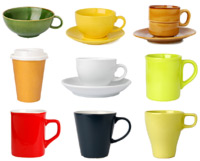 Cups found little favour with our experts, with El Presidente frowning on their use "unless it's cha or otherwise ceremonial; high, cream etc".
Cups found little favour with our experts, with El Presidente frowning on their use "unless it's cha or otherwise ceremonial; high, cream etc".
Peter Taylor concurred: "The important thing to remember though is that it must be served in a mug. I can’t bear bone china, and fear I'd be laughing stock in the IT dept if I ever lifted a cup…"
Furthermore, Andy O'Rourke mandated: "You should use the same mug throughout the day without washing, the last cup of the day should be in a cup that has been thoroughly stained a bright orange colour :-)"
Preheat?
 Tradition dictates (as indeed did my gran) that the pot must be pre-warmed with boiling water before the tea brewing commences, although plenty of you seriously doubt preheating has any effect on the resulting cuppa.
Tradition dictates (as indeed did my gran) that the pot must be pre-warmed with boiling water before the tea brewing commences, although plenty of you seriously doubt preheating has any effect on the resulting cuppa.
Alan Drury reminisced: "I come from a long line of tea-drinkers and my Mother and Grandmother would demand that the water be fully brought to boiling point, the pot scalded before use."
Merlinski entered the fray with: "People warm the teapot, so why not the cup? Essential as it also removes whatever evil contaminants left behind by the dishwasher's rinse aid."
Brewing time
 A K Stiles pretty well summed up the "time according to taste" consensus, estimating "3-7 minutes in the pot with a cosy". This time scale was extended by an anonymous reader to 7-9 minutes, who explained: "Less than 7 isn't worth it, more than 9 isn't so good."
A K Stiles pretty well summed up the "time according to taste" consensus, estimating "3-7 minutes in the pot with a cosy". This time scale was extended by an anonymous reader to 7-9 minutes, who explained: "Less than 7 isn't worth it, more than 9 isn't so good."
Andrew Moore favoured six minutes for his cafetière-brewed darjeeling/assam mix, exceeding the four minutes suggested by Identity for a African loose tea concoction. Seanmon served up a compromise, with "at least 5 minutes" in the pot (with tea cosy).
Overall, six minutes looks to be a good compromise (see ISO 3103, below), but we'll let you have a further say on the matter in due course...
Cow juice with that?
 On the thorny question of milk/no milk, Peter Gallagher unhelpfully (or perhaps helpfully) suggested: "For the best cup of tea you need to get rid of the milk and replace it with whisky."
On the thorny question of milk/no milk, Peter Gallagher unhelpfully (or perhaps helpfully) suggested: "For the best cup of tea you need to get rid of the milk and replace it with whisky."
While this may be true if you're recovering from exposure to cofftea, a majority identified cow juice as a vital ingredient of a classic cuppa, although there was little agreement on whether it should be full-fat, semi-skimmed or skimmed. Apparently, though, there are scientific considerations here, as El Presidente illuminated: "Full fat milk but not too much because the lactose takes away the bite of the tannin."
Rather less scientifically, the appropriately-monikered Irongut came in guns blazing with: "FULL FAT MILK ONLY! None of this hemi demi semi skimmed shite."
John Tserkezis chanced his arm with his choice of "cold soy milk", while an anonymous expert wisely cautioned: "Never use condensed milk."
Milk when?
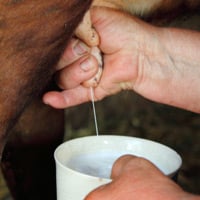 So, does the milk go in the drinking receptacle before or after the tea? You may dismiss this as a matter of small import, but you'd be wrong.
So, does the milk go in the drinking receptacle before or after the tea? You may dismiss this as a matter of small import, but you'd be wrong.
Charlotte Davies summed it up thus: "The milk goes in first, and then the tea."
AJ MacLeod agreed: "Milk is definitely best added first, you just need to learn how much to add for your particular tea and brewing duration."
Alan Drury popped up again, explaining that his mum and gran insisted "the milk should always be put in the cup before the tea was poured". He adds: "They both used to swear blind that they could taste the difference if any part of this procedure was omitted."
Frumious Bandersnatch was on hand to explain: "Absolutely need to put the milk in the cups first, otherwise you scald the milk. You might not believe this, but do a blind taste test and I think you'll be able to tell the difference.
Obviously, the above applies only to a teapot scenario. Nobody in their right mind would put milk in first when making a brew in a mug with a teabag, would they?
Chillingly, they would, as a shaken Andrew Cope told us: "Whatever you do do not do what my colleague does. He puts the milk in immediately and has even been known to put the milk in with the tea bag while waiting for the kettle to boil."
Well-travelled readers will confirm the this horrific practice is the tea-making method of choice in pagan lands, where puny teabags of suspect origin are dunked in lukewarm water to produce an affront to civilised tastebuds.
Drawing a veil over this barbaric practice, we can proceed to...
Sugar?
 Added sweetness is a matter of taste, but it provokes strong opinion. Kieran Holland was pretty clear on this one, thundering: "NO SUGAR - The taste of sweet tea is only something I can stomach if I’m camping, and its bloody cold, and someone else made it."
Added sweetness is a matter of taste, but it provokes strong opinion. Kieran Holland was pretty clear on this one, thundering: "NO SUGAR - The taste of sweet tea is only something I can stomach if I’m camping, and its bloody cold, and someone else made it."
John Robson agreed, noting: "Sugar is an abomination unto Nuggan."
For the opposition, Putters mandated no less than three sugars. He is presumably not a member of his local Diabetic Tea Lovers Association.
Ok, so we're agreed that we haven't got the foggiest what represents the zenith of cha, personal preference aside. We at Vulture Central are, nonetheless, determined to at least narrow the field for the benefit of those who have not yet partaken of the divine nectar and are seeking enlightenment.
We're still mulling just what kind of test might enable us to get closer to our goal, and are obliged to those readers who pointed us in the direction of the splendid ISO 3103, aka BS 6008, which quite rightly secured the 1999 Ig Nobel Prize for Literature:
- The pot should be white porcelain or glazed earthenware and have a partly serrated edge. It should have a lid that fits loosely inside the pot.
- If a large pot is used, it should hold a maximum of 310 ml (±8 ml) and must weigh 200 g (±10 g).
- If a small pot is used, it should hold a maximum of 150 ml (±4 ml) and must weigh 118 g (±10 g).
- 2 grams of tea (measured to ±2% accuracy) per 100 ml boiling water is placed into the pot.
- Freshly boiling water is poured into the pot to within 4–6 mm of the brim. Allow 20 seconds for water to cool.
- The water should be similar to the drinking water where the tea will be consumed.
- Brewing time is six minutes.
- The brewed tea is then poured into a white porcelain or glazed earthenware bowl.
- If a large bowl is used, it must have a capacity of 380 ml and weigh 200 g (±20 g).
- If a small bowl is used, it must have a capacity of 200 ml and weigh 105 g (±20 g).
- If the test involves milk, then it is added before pouring the infused tea.
- Milk added after the pouring of tea is best tasted when the liquid is between 65 - 80 °C.
- 5 ml of milk for the large bowl, or 2.5 ml for the small bowl, is used.
Quite magnificent, although we want to jig the parameters according to our readers' opinions. Accordingly, we've prepared the following poll to better determine the lie of the land. Note that we don't offer a selection of tea types. This would be impractical, given the sheer number suggested.
When we've examined the results, we'll use them as the basis for a final showdown, using the most popular teas you've already nominated. Exact details of this epic experiment will follow in due course, so take it away...